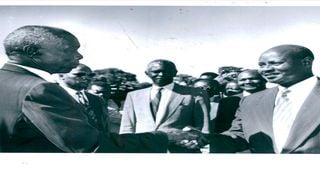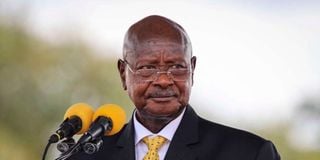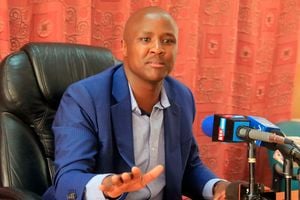
In this undated photo, Presidents Daniel Moi and Yoweri Museveni shake hands at Malaba border town when the Ugandan Head of State arrived for talks.
| File | Yusuf Wachira | Nation Media GroupWeekly Review
Premium
The historic handshake that stopped Kenya-Uganda war
What you need to know:
- In 1987, the Ugandan Army had just triggered a fierce cross-border war. By the time the sound of the gunfire ended, an estimated 57 soldiers had been killed on both sides.
It’s not uncommon for residents of the border town of Busia to cross over to Uganda, or the “no-man’s land”, guzzle illicit brew in full view of Kenyan police, and stagger back home past the helpless law enforcers with the evidence safely stored in their systems.
This provocative action is mostly witnessed during public holidays and end-year/Christmas festivities, and imbibers are persuaded by the fact that, unlike in Kenya, the consumption of the chang’aa, known by the locals as “enguli”, is legal in Uganda. The economic realities, heralded by the fact that the cost of alcoholic beverage is friendlier in the neighbouring country, is another push factor.
The locals have former President Daniel arap Moi and Uganda’s President Yoweri Kaguta Museveni to thank for the “paradise” and lawless territory that is no-man’s land. However, the territory – located where sections of Sofia and Marachi estates were situated – did not come into existence out of leisure or by design.
No-man’s land was a product of a fierce cross-border battle, which necessitated the creation of a buffer zone between the two nations, leading to a ceasefire.
Exactly 36 years ago, a Moi-Museveni handshake at Malaba Primary School on the Kenyan side of the border hammered out a deal between the two East African nations that ended cross-border hostilities. In 1987, the Ugandan Army had just triggered a fierce cross-border war. By the time the sound of the gunfire ended, an estimated 57 soldiers had been killed on both sides.
The historic handshake ushered in a ceasefire and marked the creation of a border buffer zone. This dramatic tale illustrates the tension among border communities over the decades and offers a glimpse on the role of previous heads of state in securing the Kenyan entry points.
The border dispute with Uganda has remained a concern for decades since independence. In mid-1970s, for instance, Uganda’s dictatorial leader, Idi Amin Dada, laid claim on the Kenyan territory from Busia all the way to Naivasha, attracting the wrath of President Jomo Kenyatta, who told him to back off or face military action.
Moi faced similar threats from Museveni, who had assumed power in 1986 after staging a guerilla war against the administration of Gen Tito Okello. The threat of annexing parts of the present-day Busia County to Kenya aside, Moi had a standing beef with Museveni. Having been tasked by regional bodies to mediate between Okello and Museveni, Moi was taken aback by Museveni’s act of trashing the peace deal he had hammered out. Museveni returned to the bush to overthrow the government.
In later years, the Mwai Kibaki and Uhuru Kenyatta administrations had to deal with the dispute of the Migingo Island. For ages, the rocky piece of land in Lake Victoria served as a docking point for Kenyan fishermen, only for Ugandan security officers to storm it in 2004.
They arrested fishermen, confiscated their fishing gear and mounted a Ugandan flag on the island. The dispute remains unresolved.
During the battle for Busia, the army barracks based at Hakati in Samia sub-county proved handy in staging fightbacks, which successfully helped to repulse the Ugandan soldiers. Akin to its name, the base, located on high grounds at the border-point of Funyula and Budalang’i constituencies and the Busia-Siaya County border, was centrally and strategically positioned. Hakati also sits next to Lake Victoria, where soldiers and residents have a clear view of the giant water body.
Uncomfortable about the military might and location of the base, Museveni reportedly demanded its closure as one of his key demands in the Malaba peace deal.

Ugandan President Yoweri Museveni.
According to Major (Rtd) Bonnie Mahaga, who hails from the county, Hakati was a full-fledged base, complete with jet-fighters. While he is non-committal on Museveni’s demands, he concurs that the station was immediately scaled down to a mere Forward Observation Base (FBO), whose activities were reduced to military intelligence. Despite the constant cross-border frictions with Uganda, Hakati – in its diminished status – remains the only military installation in the entire western Kenya.
With increased developments in Kisumu as a crucial regional hub, Maj Mahaga views the lakeside city as a possible target of an attack: “With the launch of ships and shipyards, including the recent one by President (William) Ruto, among other developments, Kisumu is vulnerable. We need to start thinking of having a naval base in the lakeside city.”
Reflecting on the events of October 1987, veteran journalist, Moses Radoli, who at the time was based in Busia, vividly recalls: “The barking automatic gunfire was from Kenya’s then standard issue G3 automatic rifle. Within minutes, the busy bus park was empty. However, some of us (reporters) rushed towards the gunfire from our then press centre at Midland Hotel.”
A cross-border war had just begun between Kenya and Uganda. The previous week, recalls Radoli, had seen the Ugandan National Resistance Army (NRA) massing troops across the border. The first AK-47 gunfire to Kenya had been unleashed by a motorbike-riding NRA lieutenant with devastating consequences.
“The Kenyan police immediately returned fire. As gunfire raged on for several days, the town’s residents fled and sought refuge in safer places more than five kilometers away from Mundika High School and beyond – the town remained to the media and the combatants,” Radoli told The Weekly Review.
What many Kenyans and even Ugandans did not know was that the then Busia District Commissioner (DC), Simon Chacha, was a former Major in the military who took to the immediate frontline.
In fact, reacting promptly to the attack during a live broadcast, Moi was poetic in his praise of the administrative officer, now deceased: “Kama mjuavyo, hawa majirani wametuletea shida jana mchana lakini Bwana DC wangu Chacha amechacha kabisa huko mpakani Busia (As you are all aware, our neighbours attacked us at daytime yesterday, but my DC, Mr Chacha, is acting tough at the Busia border point).
President Moi then ordered immediate reinforcement of police, including the General Service Unit (GSU), from neighbouring districts who staged a camp at the Busia Agricultural Farmers Training Centre (ATC), which presently houses Governor Paul Otuoma’s official offices. The DC’s residential house had been targeted in the gunfire by the NRA.
For months, tensions between the two countries had been rising and by October 1987, they escalated into cross-border gunfire. This was followed by accusations and counter-accusations from Kampala and Nairobi.
Malaba, which is the second largest Kenya-Uganda cross-border town, was the venue of the talks. The meeting between Moi and Museveni took place at St Michael’s Malaba Township Primary School. The then school’s Parents and Teachers (PTA) Chairman, Ibrahim Ojeje Asman, recalls: “There was very tight security not just around the school but all over Malaba town. Not just the regular and administration police, but also GSU, and segments of the Kenya Defence Forces that had been brought in by Nyayo buses.”

Trucks in Malaba on the Kenya-Uganda border. The slow clearance of goods and trucks cost businesses millions of shillings.
At the neighbouring Malaba Health Centre grounds, there were four military helicopters parked, while security men panned out over large areas with sophisticated communications gear and guns, all around the school and strategic locations in town. He goes on: “There were three white tents erected in the school’s ground overnight under tight security inspection. One was for members of the public, another for senior government officials and the third complete with red carpets that hosted the two presidents and their cabinet ministers.”
“President Moi was the first to arrive with his team travelling from Eldoret and when Museveni came, people started booing and heckling him and even tried to block his lean motorcade, but Moi prevailed upon them to let him through.”
After exchanging greetings, Moi assured Museveni that he had only deployed policemen, not the military, “otherwise within three hours or less we would be in Kampala and you would have nowhere to run to or nothing defend”. A retired senior chief of Ang’urai location, who helped in organising the venue alongside DC Chacha, Alfred Olubai, says by the time they got orders from the DC, “our men had already repulsed an attempted attack on Adungosi Police Station by NRA soldiers disguised as women in ‘Gomesi’ (the women’s traditional dress)”.
“The atmosphere was tense and the only introductions done were those involving individuals accompanying the two presidents. Then they went on to discuss their business in their special tent, heavily guarded by security teams with Museveni’s bodyguards conspicuously wearing white gumboots,” recalls Olubai
Ideally, this is how peace was restored, and how the border towns of Sio Port, Busia, Malaba, Lwakhakha and Swam were secured.
But efforts to sustain the peace remains a daily challenge for Busia leaders. The situation gets dicey every election year with claims of poll rigging and interference by President Museveni.





